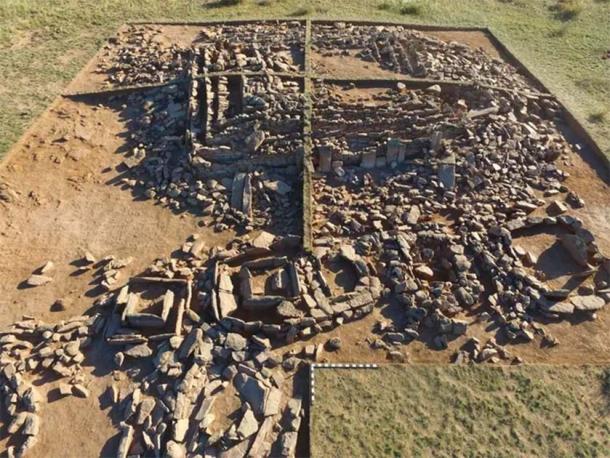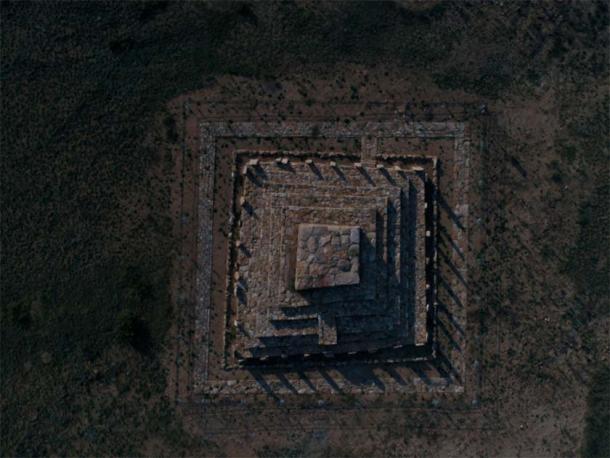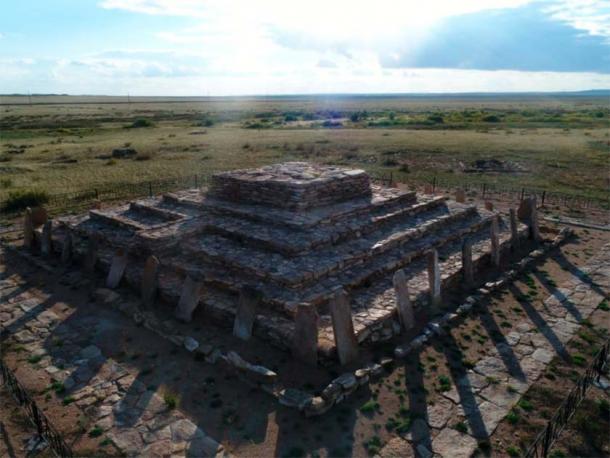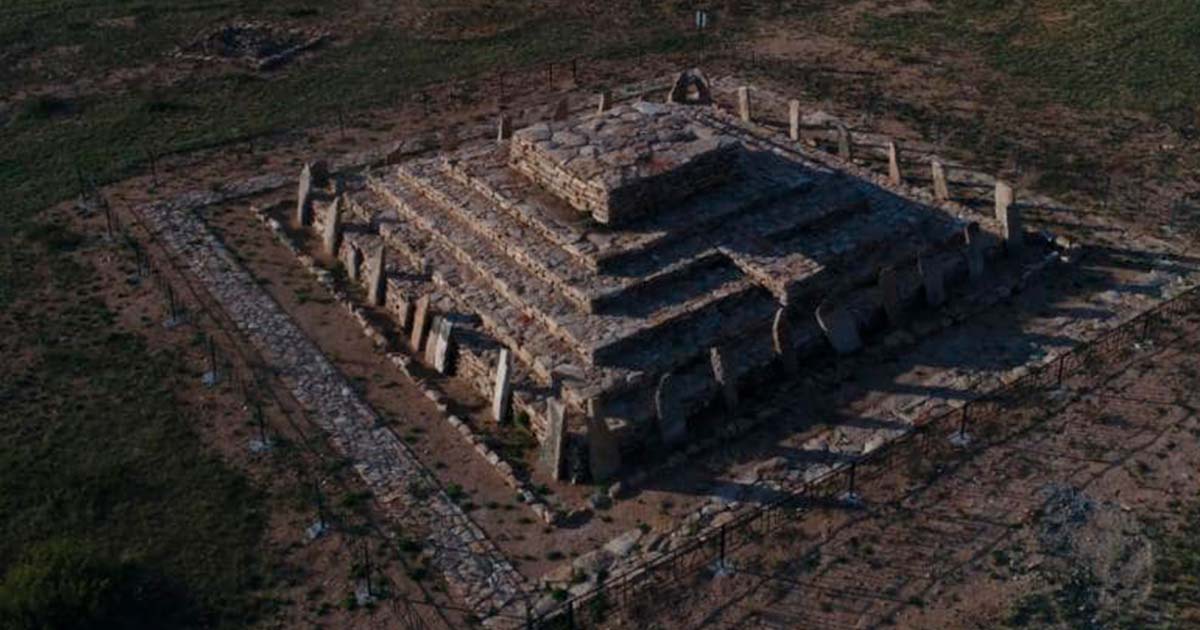Stunning 3,400-Year-Old Pyramid in Kazakhstan Was a Monument to a Deceased Leader
In 2016 the remains of a fascinating pyramid-shaped monument were discovered in the windswept and largely deserted Karaganda region of central Kazakhstan. This five-layered stepped structure was eventually put back together stone by stone, revealing it to have been a monumental mausoleum likely built sometime in the second millennium BC. After years of study and analysis, experts have now concluded that the pyramid-shaped tomb was constructed between 3,200 and 3,400 years ago as a burial site for an important leader of the Begazy-Dandybai people, a group linked to the ancient Andronovo culture that dominated Central Asia at that time.
The Karajartas mausoleum, as the structure is called, was built on the top of a hill overlooking the Taldy River in Karaganda’s Shet district. It was fully unearthed and reconstructed by archaeologists affiliated with the Saryarka Archaeological Institute at Karaganda State University, who’ve been studying this remarkable find, along with other ruins and artifacts excavated nearby, for the past seven years. While they’ve long suspected the mausoleum was a creation of the Late Bronze Age Begazy-Dandybai culture, the latest research confirms this and helps establish a timeline for when these industrious people actually occupied the region.
- Archaeologists Uncover a Prehistoric Step Pyramid in the Steppes of Kazakhstan
- Exceptionally Preserved “Still Shining” Bronze Age Sword Unearthed in Bavaria

Begazy-dandybay chief's mausoleum, Kazakhstan, before it was reconstructed. (Viktor Novozhenov)
Discovering the Monumental Mausoleum Builders of Ancient Kazakhstan
The most recent conclusions about the mausoleum’s age and purpose were announced by Dr. Aibar Kassenali, one of the leaders of the ongoing excavations. Dr. Kassenali explained that carbon-14 dating tests have shown that the pyramidal structure must have been built between the 14th and 12th centuries BC. This makes it contemporary with other pyramid-shaped mausoleums in the region, which were also constructed by the Begazy-Dandybai people (although not necessarily at the same time).
Based on how challenging the construction of such an elaborate monument would have been for the ancient residents of Kazakhstan, Dr. Kassenali and his colleagues are certain the tomb was built to honor a revered political or military figure.
“The presence of multiple pyramidal stepped mausoleums detected in the region shows that the Taldy River valley, located in the Sari Arka steppes, was used by the Andronovo communities in the Bronze Age as the Valley of Kings where their great leaders were buried, like the Nile Valley in Egypt,” the researcher told the Turkish news outlet TRT Haber in a recent interview.
- Kazakhstan Valley Filled with Giant Balls Has Geologists and Fringe Scientists Butting Heads
- Archaeologists Unearth the ‘Golden Man’ of the Saka Burial Mound in Kazakhstan

Ariel view looking down on the mausoleum. (Dr. Aibar Kassenali/TRT Haber)
“Looking at the cut stones found in the pyramid, the size of the mausoleum, and the fact that such a huge structure was built in the Bronze Age in a very arid region such as the steppe is an indication of the high understanding of art and rich spiritual beliefs that the Begazy-Dandybai communities have reached,” Dr. Kassenali added.
When the ruins of this unique structure were unearthed in 2016, it was misreported that the mausoleum was a full-sized pyramid that rivaled the Egyptian pyramids in size and age. In fact some outlets even reported that the world’s oldest pyramid had just been found in Kazakhstan, claiming that the mausoleum had been constructed even before Egypt’s step pyramid of Djoser, which was erected about 4,500 years ago.
These rumors likely flourished because of the remoteness of the discovery site (the empty plains and rolling hills of central Kazakhstan are located far from the media centers of the United States, Europe and Asia). But eventually the truth was revealed, that this structure was no more than about seven feet (two meters) high and had been constructed more than 1,000 years after the pyramid at Djoser.
It took four excavation seasons to complete the reconstruction of the ancient mausoleum, which would have been a prominent feature on the landscape 3,400 years ago. It would have been visited frequently by family members of the deceased and by community members paying tribute to a respected leader. It likely would have survived intact perched on its hilltop for centuries, helping connect the people of ancient Kazakhstan maintain a connection with their ancestors and the cultures of the past.

The restored mausoleum pyramid indicates a very impressive burial monument was once constructed. ( Dr. Aibar Kassenali/Arkeonews)
The Begazy-Dandybai People: A Brief History
As the largest landlocked country in the world, Kazakhstan is located just to the south of Russia, straddling the border between Asia and Europe. It has historically been a crossroads for nomadic peoples and empires, and as such it was subject to domination by different migrating groups or powers at various points in its history.
In the second millennium BC its primary inhabitants in the desolate Karaganda region were the people of the Andronovo culture, who thrived in Siberia and nearby Central Asian territories between 2,000 and 1,150 BC. The Begazy-Dandybai people emerged during the Andronovo period, and this Late Bronze Age culture was at the height of its power from 1,350 to 1,150 BC.
Originally the Begazy-Dandybai culture was dated to a later period, specifically to the 12th through eighth centuries BC. But the most up-to-date work at dozens of archaeological sites (including the site of the pyramid mausoleum at Shet) has corrected this error, grounding them firmly within an Andronovo context.
More than 200 Begazy-Dandybai burial sites have been found in Central Asia, featuring modest tombs for most of the deceased but much grander monuments for others. Monumental mausoleums were reserved for clan leaders and other important elites, and the newly reconstructed pyramid tomb overlooking the Taldy River represents one of the most striking and best-preserved examples of this type of structure.
While the Begazy-Dandybai people disappeared from Central Asia long ago through the forces of assimilation, they left an indelible imprint on the landscape. The ruins of the mausoleums they left behind are an indication of how seriously they took their burial practices and the rituals associated with them.
The Complex Web of Ancient History Revealed in the Hinterlands of Central Asia
The burial chamber found in the mausoleum had been broken into and robbed a long time ago. But a cemetery unearthed nearby produced artifacts that revealed details about the culture that built it.
“Especially the motif style of the ceramic vessel detected in the grave site, which was manufactured without the use of wheels and decorated with the printing method, shows that it belongs to the Begazy-Dandybai period, which constitutes the last phase of the Andronovo period,” Dr. Kassenali stated.
Excavations in the area have also unearthed ruins from a small urban enclave that would have been occupied by the Begazy-Dandybai people.
“This settlement, which extends over an area of 15 hectares, existed chronologically in the same historical period as Troy 4 in Asia Minor, the Early Mycenaean period in mainland Greece, and the advanced period of the Middle Kingdom in Egypt,” archaeologist Dr. Serhan Çınar told TRT Haber. “The settlement has a series of walls, a planned street network, and water collection systems.”
The researchers believe the Begazy-Dandybai communities of Kazakhstan were closely related to the Prot-Turkish culture, which was in turn linked to the Karasuk culture of southern Siberia. This is demonstrated by the corridors leading to the burial chambers in their monumental mausoleums, which open toward the direction of sunrise, a custom derived from ancient Turkish religious beliefs. It is also revealed in the scripts, seals and imagery found on Begazy-Dandybai artifacts, and also on artifacts from the Scythian-Saka culture that arose in the region following the decline of the Begazy-Dandybai people (the Begazy-Dandybai and Scythian-Saka would have been closely related).
As excavations continue, the archaeological team from Karaganda State University will be investigating connections and relationships like these, as they seek the truth about the complex patterns of settlement, migration and interbreeding that shaped the historical development of Kazakhstan and the surrounding region.
Top image: The impressive, restored 3,400-year-old pyramid mausoleum found in Kazkhastan. Source: Dr. Aibar Kassenali/Arkeonews
By Nathan Falde

















